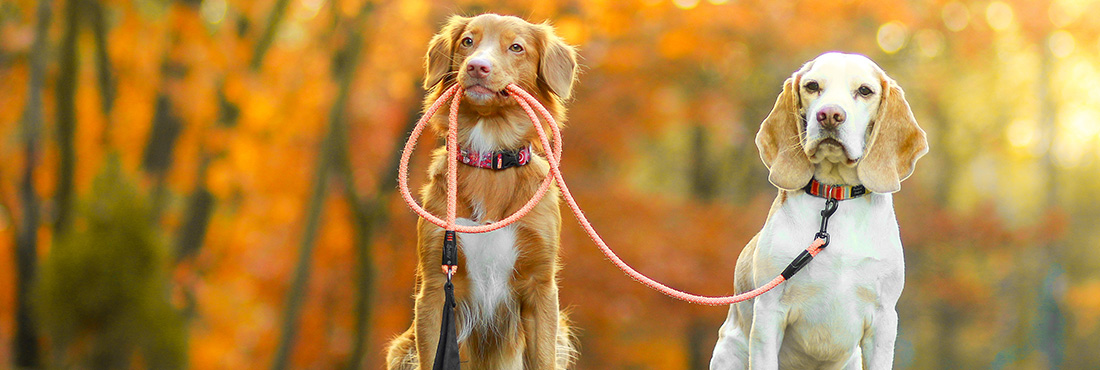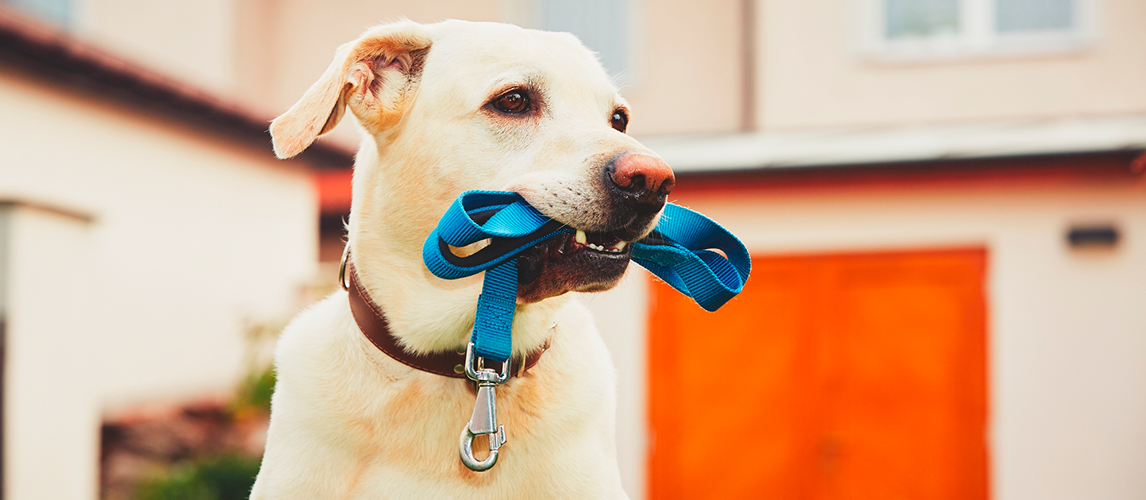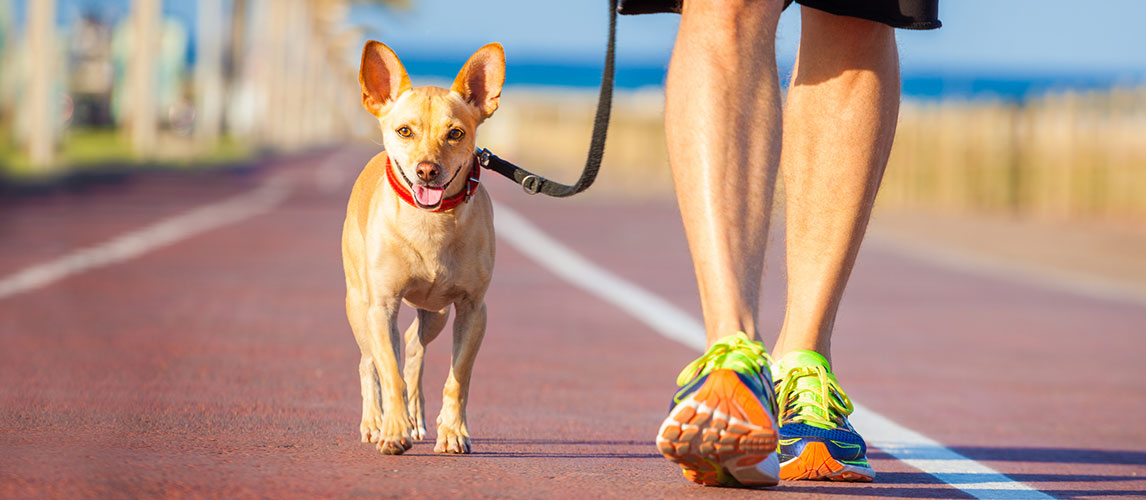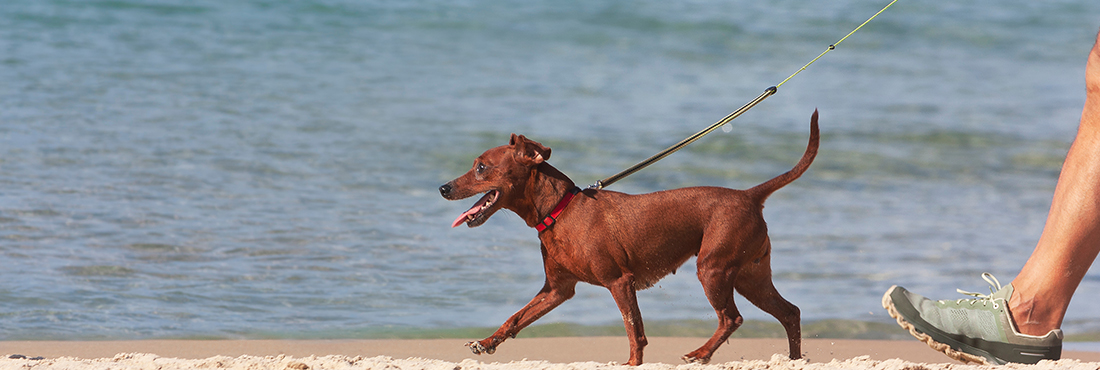Being a new puppy parent is an exciting time but doesn’t come without its challenges. Leash training is one of the numerous tasks you will face when teaching your puppy, so we’ve comprised a handy and informative guide to leash training.
When to Start Leash Training
Leash training can begin the minute you bring your puppy home. In fact, the earlier you start with them the better as it will not only teach them leash etiquette but will also help you bond with your puppy.
Typically, you can expect to bring a pup home when they have reached 12 weeks of age. At this age, they will pick up on training quickly as they will soak it up like a sponge. However, it’s important to acknowledge that this might not be the case if you have a breed that is known to be stubborn. Nevertheless, with the right attitude and resources, training will be a walk in the park. Pun intended.
Important Steps Before You Start
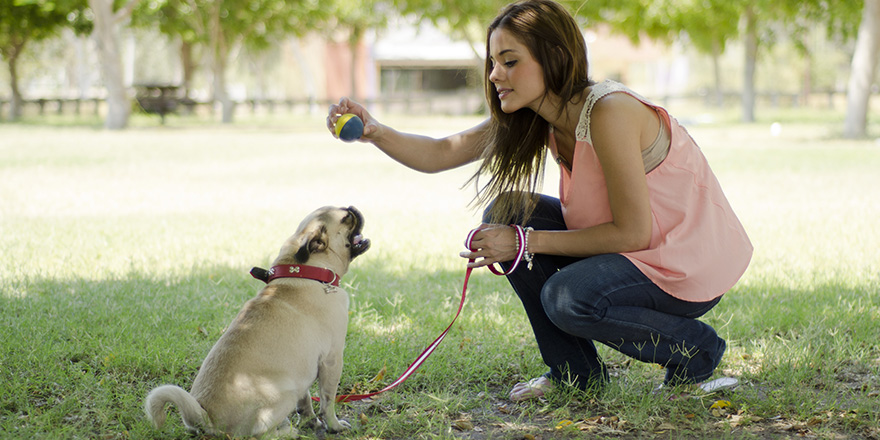
Before you get your puppy on a lead and take them straight outside, read the below information. Here, you can find everything you need to purchase and do before you head out of the door. It’s vital that you follow these steps to ensure your training runs smoothly.
What Do You Need When Leash Training Young Puppies?
Leash
Of course, a leash is the number one item you’ll need for training your puppy. However, to begin with, it’s recommended that you start with a non-retractable leash as they can encourage puppies to pull, lurch forward, and even jump. At a certain point, when you’re confident with your dog, you can always replace the leash with a retractable alternative.
Make sure you get yourself a leash that is around four to six feet in length, as this will give them space to explore whilst keeping them near to you.
As an added note, look for a leash with a comfortable handle. Your puppy will inevitably tug and pull as you’re walking so make sure that the handle is comfortable to hold and won’t likely cause any friction marks to occur.
Harness or Collar
A harness or collar can be used when practicing leash time but for stronger pups, a harness, or even a head halter, may be more suitable. Make sure that the harness or collar is suitable for the puppy and fits comfortably. If they are inclined to pull, a comfortable collar/harness won’t strain or injure them.
Treats
Using your puppy’s favorite treats is a great way to keep them engaged in their training. If they know there is a chance they might get a tasty treat, they’ll surely have eyes on you from the start.
Patience and Dedication
Dedication goes without saying as concise and consistent training will pay off massively. Showing your puppy patience is also vital, as most dog breeds respond well to positive reinforcement and will naturally push boundaries if you are impatient or harsh.
Other Tools:
Along with using treats, clicker training is also an effective method. The clicker concept is used to reward and acknowledge good behavior as opposed to only acknowledging bad habits.
A reliable GPS tracker may be something worth considering if your puppy is notorious for his disappearing act. If you’re nervous about puppy walking in the great outdoors, it may be something worth investing in for peace of mind. If they should go missing – you’ll be reunited in no time.
What to Do Before You Leash Train Your Puppy
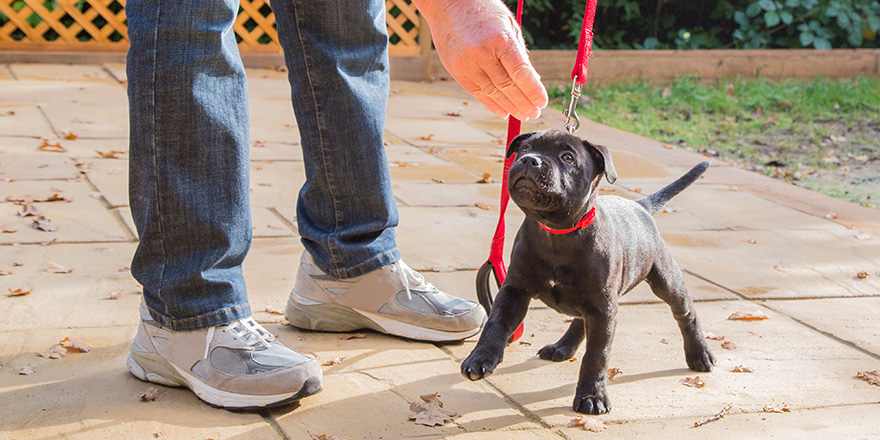
As puppy parents, you may be eager to start the lessons, but your lessons will flop without considering the aspects below. It can seem obvious to buy a leash or harness when puppy training, but make sure you read into each category below to understand how to make the process run more smoothly.
Introducing the collar or harness
Once you have everything you need, it’s time to introduce the leash and collar to your puppy. Start by showing your puppy the collar or harness making sure to offer treats or praise when interacting with it. By doing so, your puppy will make positive associations with the items and be less likely to become anxious at the sight of them. This can also prevent them from biting or scratching at them when leash training.
Once your puppy is familiarized with the collar or harness, it’s time to try them on. Make sure you reassure and praise them when doing this. Once the collar is on, take it off instantly. After a few repetitions, you can start to leave the collar/harness on for longer if they are comfortable.
When leaving the collar/harness on for longer periods of time, engage your puppy in playtime. You can also put the collar on before training or meals, so they associate it with things they love.
Tip: When introducing the items to your puppy, ensure you do this at home to minimize distractions.
Introducing the leash
Once your pup is happy and comfortable in its collar/harness, you can now introduce the leash. Like the other items, let your dog sniff and approach the leash while offering praise and the occasional treat-shaped reward.
Allow your puppy to walk around the house with the leash attached. If the leash becomes the focus of their attention and they are constantly aware of it, distract them with toys as they will sometimes begin to gnaw or bite at it. This is a behavior you want to nip in the bud when they are young to prevent them from being difficult later on.
How to Train a Puppy To Walk on a Leash
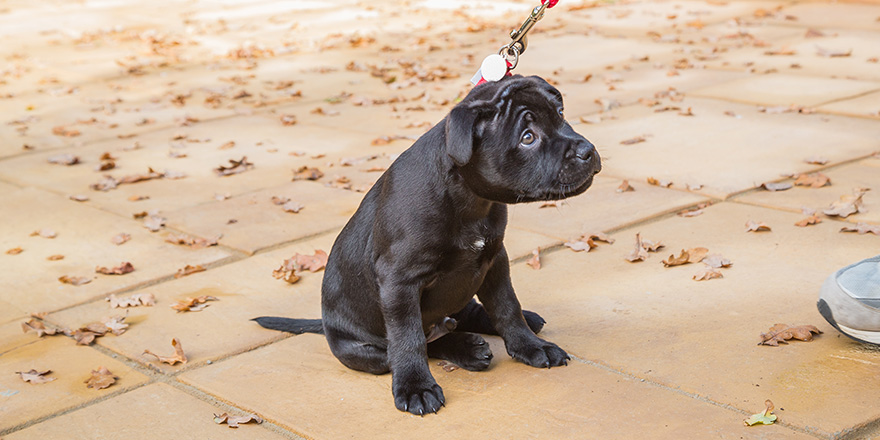
So, after you’ve followed the steps above you may be wondering about the best way to get started. Here you can find valuable information and tips for successfully training your puppy on a leash.
Practice Walking and Basic Commands Inside and Outside
You can begin walking with them when you’re confident that your puppy has adapted well to their collar and leash time. To begin with, walk with them at home around your home and even in the backyard as these are areas they are familiar with that have little to no distractions. A distraction-free area will ensure they stay focused and won’t try to pull away to go sniff all of the new smells.
How to Start Leash Training
Taking small steps is the key to teaching your puppy to walk nicely at your side. First, call your puppy to your side and reward them when they arrive. The objective is to keep your puppy close to you so that when you take a step, they also take a step with you. You will also want to keep a short leash that isn’t as bad as you think. Keeping the leash short will prevent your puppy from getting tangled as they walk.
Each time you walk forward, make sure you pause and praise them when they are at your side. This will reinforce the importance of being close to you. In addition, dogs have a strong pack mentality, if they view you as the alpha, they will fall in line and listen to your commands.
When you begin to pick up the pace, taking a few steps at a time, you can begin to use loose leash walking. You and your dog must keep to a walking rate that you’re both comfortable with. As you may expect, the size of your dog will have an impact on their speed so bear this in mind when puppy training.
Remember
It’s important to remember to keep praising their good behavior when training. This goes especially when they are happily walking alongside you on a loose leash. Your puppy will inevitably become distracted so remain patient. If they lag behind, refrain from tugging their leash and remind them you have tasty treats.
Heel Training
As they get used to walking indoors and eventually outdoors, you can trust them to explore their surroundings more on a loose leash. Having said that, you will need to make sure that they are trained to heel and respond to your voice.
Heel training will ensure your dog remains close to you if you suspect something might pull their attention away. Similar to walking, you want to keep your dog close, specifically at your side. Moreover, it is recommended that you begin this puppy training indoors so that they cannot be distracted.
- Start by calling them to your side and rewarding them with a treat.
Tip: When you teach your puppy to heel at your side. Begin with picking either the left or right side but make sure they keep to the chosen side going forward.
- To keep them at your side, continue to praise them with kind words and treats.
- When taking another step forward, you will want to entice your dog to the same side again with a treat. Continue doing this making sure you have their focus on their favorite treat.
- If your dog begins to stray, refrain from scolding them and simply guide them back to where they need to be.
- When you feel confident that they have gathered these initial steps, pick up the pace a little. Try walking quicker and immediately stopping at random points. When your dog halts to your side – reward them!
- This is when you can introduce the command ‘heel’. When your dog follows and stops at your side, utter the command and reward them so they can associate the word with the action.
- It’s always worth assigning a release word or phrase so they understand that they can be left to their own devices. When you’ve chosen your word, at the end of your training, use it and throw a treat or toy in another direction.
- When these steps are completed, you can put them to the test on outdoor walks.
Stopping Bad Behaviors
Dogs will inevitably become distracted when they walk outdoors since there are hundreds of new sights, smells, and sounds to soak up. They will begin to pull at times, but it’s important to remain patient and use a few simple tricks to keep your furry friend paying attention.
When your puppy starts pulling, reign the leash in to give him less room to explore. If he continues to pull, stop walking and allocate a word to let him know he needs to stop. Before you continue, wait until you have a loose leash and for your dog to acknowledge your command. You can also use treats to reset their behavior.
Some dogs are naturally more stubborn or headstrong than others, so there’s no harm in seeking advice or help. Some very valuable tools online could put you in contact with a dog training expert that could help enhance your pup’s leash skills.
Leash Training Troubleshooting
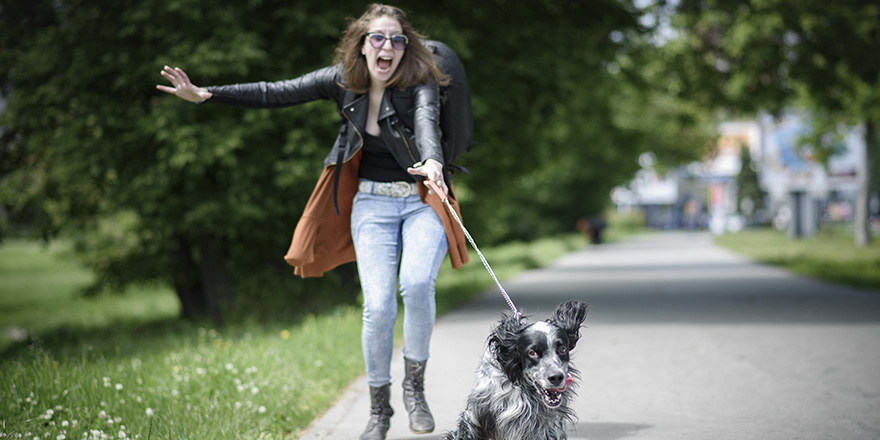
How to Stop a Puppy from Biting a Leash
Leash biting or chewing can be a sign that your dog is excited, anxious, or overwhelmed. The best way to combat this is by resetting their behavior. Similar to when your dog pulls, when your puppy starts to gnaw the leash, stop walking. Pique their interest with a treat, but don’t immediately give it to them as they might think chewing = reward!
Have your puppy perform a trick or command. Have them sit first so you can get their full attention before requesting the trick. When the command and trick have worked, give them the treat and resume your walk.
Tip: Pay attention to potential triggers that could be causing your puppy to chew. Are there many dogs around? Maybe small critters scurrying into trees that have caught their attention? Stay alert so that you can devise a solution when you can pinpoint the trigger. For example, if other dogs or people seem to be the cause, find a quiet walking route.
How to Stop Puppy Pulling on a Lead
It can be infuriating when your dog pulls on their leash frequently, but there’s a simple solution. Refrain from tugging their leash as you could injure them. Instead, stop walking and call them back. When they come back to your side reward them and resume your walk.
If your dog is particularly energetic, you may need to exercise them more as constant pulling may signify that they need to burn off more energy. Dog sports are also a great option for pet parents as they can burn off energy, mentally stimulate them, and even strengthen your bond.
Happy walking!

